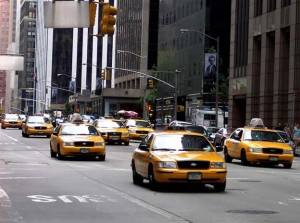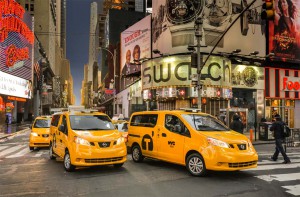After years in development, a tough shoot-out among competitors, and a series of legal challenges, New York City’s Taxi of Tomorrow is officially on the road.
But, in typically blasé Big Apple fashion, the formal launch of the modified Nissan NV200 vans has largely been ignored by city officials and taxi riders alike.
The official transition comes five months after the April 2015 date set by the NY Taxi & Limousine Commission. And many of the city’s cab riders might not even notice the change, at least not immediately, as it could take several years before the Nissan yellow cabs dominate on city streets.
The Japanese automaker won a three-way shoot-out four years ago to replace the long-familiar Ford Crown Victoria as the taxi of choice for New York’s big yellow fleet. Nissan had gone up against a variety of alternatives, the three finalists also including a Ford SUV and a unique cab developed by a company in Turkey. That overseas entry actually won a non-binding vote by city residents, but the Taxi Commission opted for Nissan’s van.
(Autonomous vehicles could take over from the cab. Click Herefor the story.)

Nissan CEO Carlos Ghosn and former NY Mayor Michael Bloomberg climbed into a prototype Taxi of Tomorrow after the maker won the contract.
Proponents claim the new NV200 cab conversion offers a number of advantages, including more room and better visibility for passengers, and improved fuel economy for fleet operators. It has a large sunroof allowing tourists to gawk at the city’s skyscrapers. There are cellphone chargers for those who prefer to gab or get work done while riding across town. Sliding doors are meant to reduce accidents. There’s even a filter system to make the new cabs smell better.
On the down side, some taller riders have complained about bumping their heads on the ceiling. And some cabbies have complained that the cabs don’t get good enough mileage, and they don’t like the base $29,900 price. Some have demanded the right to buy hybrids and other, more efficient vehicles.
Authorities have backed down a bit. They will allow cabbies and fleet owners some flexibility to order a small number of alternative models. Meanwhile, authorities got Nissan to offer modifications to allow the addition of a wheelchair ramp. The city’s goal is to have 50% of the new taxi fleet wheel-chair accessible by 2020.
Politics even got into the typically New York-style debate. Nissan took criticism for doing business with Iran, for example.
The project was championed by former Mayor Michael Bloomberg, but disparaged by new Mayor Bill de Blasio. In his previous role as the city’s public advocate, de Blasio tried to sever the 10-year contract.

The Nissan NV200 will replace a variety of different models, but the old Ford Crown Victoria long dominated NY's cab fleet.
The deal ultimately went through a series of legal challenges. At one point, the Manhattan Supreme Court voided the award to Nissan, but in June the last court battle wrapped up in favor of the Taxi of Tomorrow program.
(Court battle over Taxi of Tomorrow ends. Click Here for the story.)
City officials indicated there was no real reason to stage any special events marking this week’s official launch of the program. And, indeed, a small but growing number of NV200 taxis have already been rolling down city streets. There currently are 750 in operations among the nearly 14,000 yellow cabs in New York.
Each year, about 2,500 to 3,000 cabs are replaced in the city, so it will be a few years before the transition is complete. Ultimately, the NV200 is expected to account for about 80% of the fleet.
Ironically, the new cabs arrive at a time when the official taxi fleet is facing a separate challenge, this one from ride-sharing services like Uber that have begun to take business away, especially among business people and upscale riders. The New York Times reports that some cabbies have switched to Uber because it can be more financially lucrative.
So, while Nissan will dominate among official cabs, New York passengers will continue to have a variety of other vehicles taking them for a ride.
(Nissan, Enterprise team up in new college carsharing program. Click Here for more.)


It should be interesting to see if this deal proves worthy or is just a political favor. The initial cost of a replacement fleet is just the beginning of a long term relationship. Now we’ll see how the vehicles perform and what maintenance is required and at what cost.
“That overseas entry actually won a non-binding vote by city residents, BUT THE TAXI COMMISSION OPTED FOR NISSAN’S VAN.” Only goes to show again that it’s not what We The People want but who donates the most money to your campaign. We have the best government money can buy.